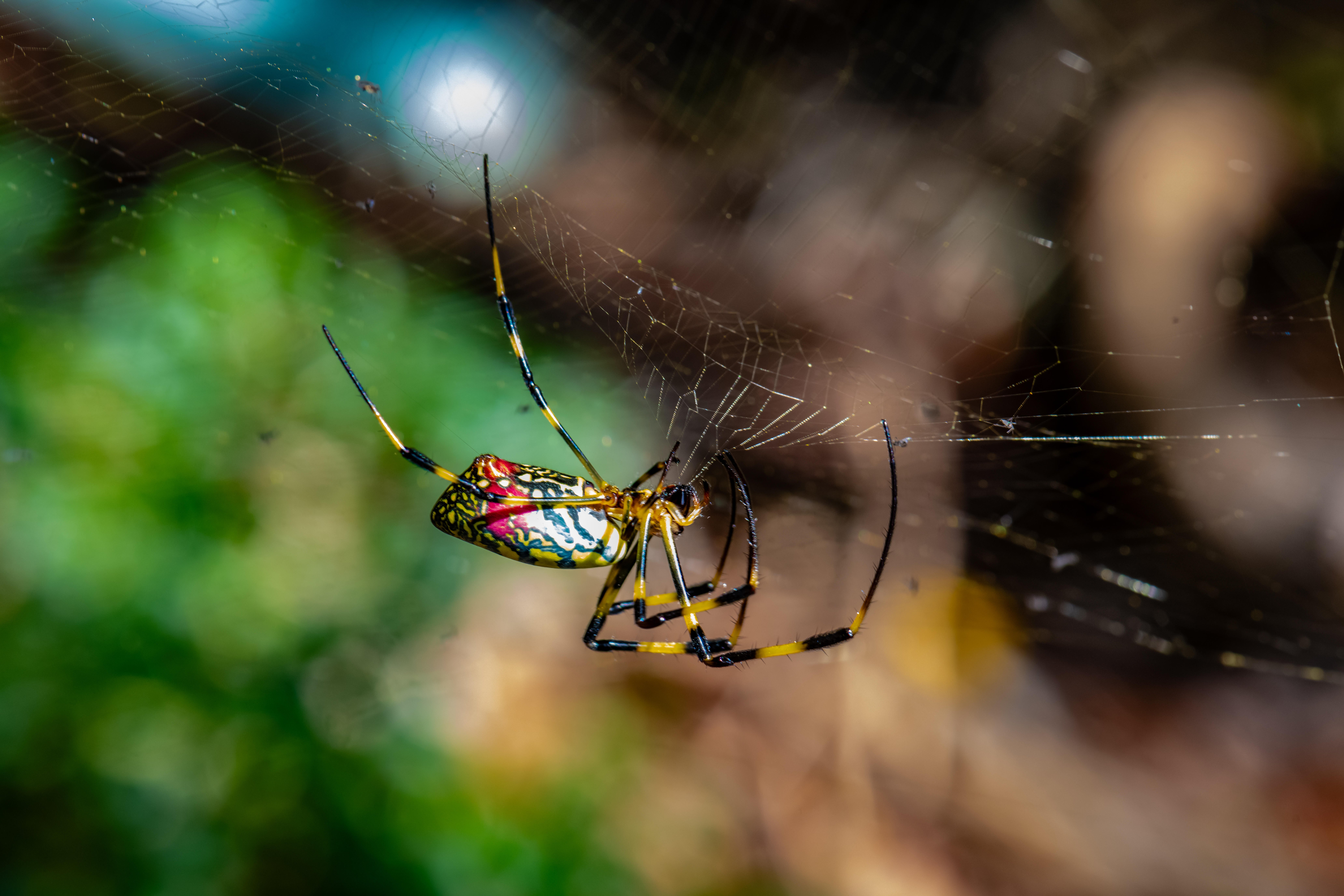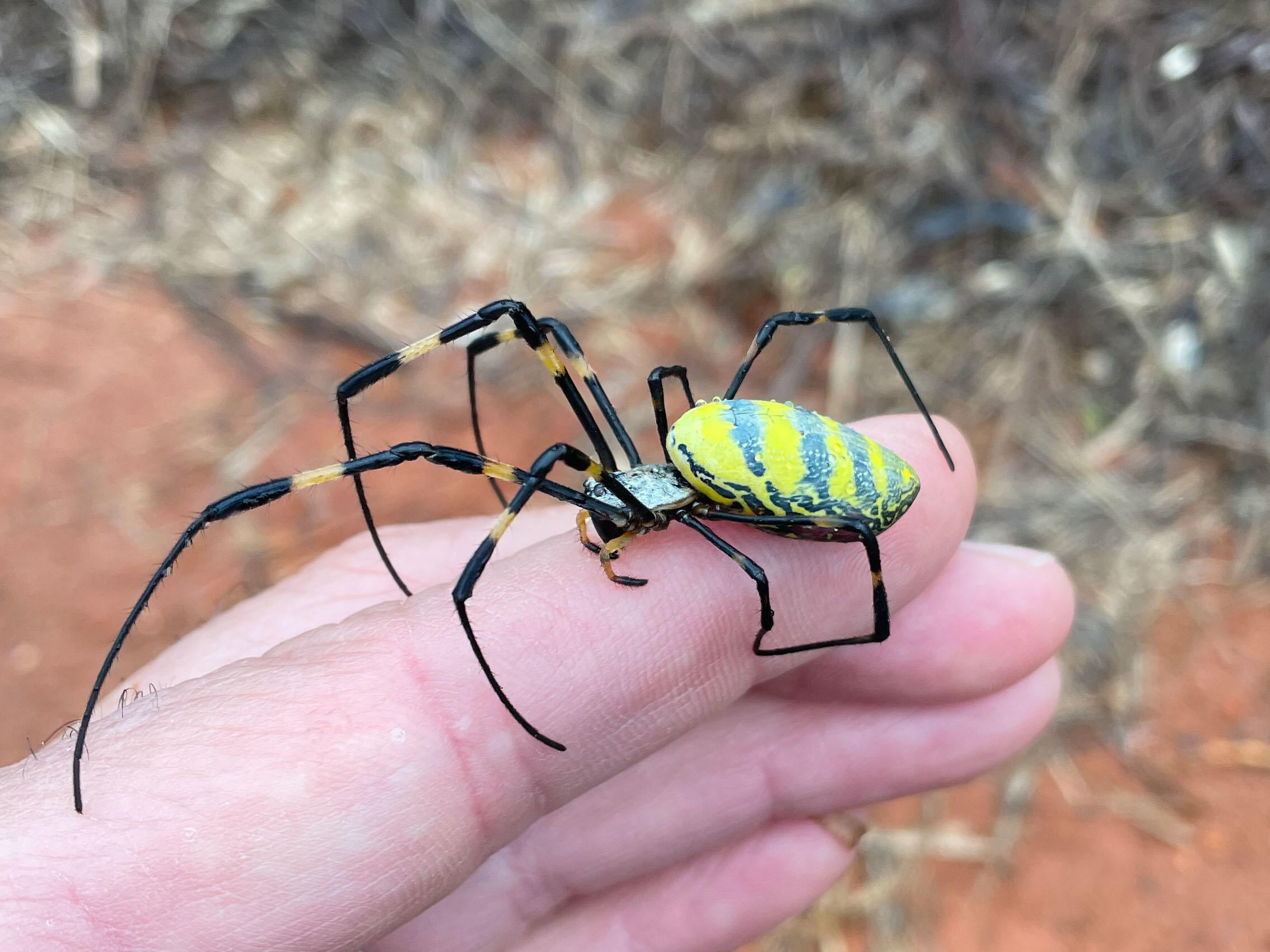Are There Spiders That Can Fly? Yes, some spiders can “fly” using a technique called ballooning, where they release silk into the wind to travel long distances. At flyermedia.net, we delve into the fascinating world of these arachnids and their aerial adventures. Understanding the science behind spider flight can provide insights into their behavior and distribution, revealing the incredible adaptations of these creatures.
1. Understanding Spider Flight: Ballooning Explained
Ballooning is a dispersal method used by many spider species, particularly spiderlings, to travel over considerable distances. But how exactly do these creatures achieve this feat?
Spiders don’t have wings, so they can’t fly in the traditional sense. Instead, they utilize a process called ballooning. This involves releasing strands of silk into the air, which then catch the wind and lift the spider into the sky. According to research from the University of California, Davis, ballooning spiders can travel hundreds of miles, facilitating their dispersal and colonization of new habitats.
1.1 The Mechanics of Ballooning
- Silk Production: Spiders produce specialized silk for ballooning, which is lightweight and strong.
- Launch Preparation: The spider climbs to a high point, such as a leaf or twig, and raises its abdomen into the air.
- Silk Release: The spider releases multiple strands of silk, which fan out and catch the wind.
- Ascent: As the wind catches the silk, the spider becomes airborne, drifting with the breeze.
1.2 Environmental Factors Influencing Ballooning
Several environmental factors play a crucial role in ballooning, making it a successful dispersal strategy.
- Wind Speed: Light to moderate winds are ideal for ballooning, allowing spiders to become airborne without being blown off course.
- Temperature: Warmer temperatures can increase the likelihood of ballooning, as thermal updrafts help lift spiders into the air.
- Humidity: Low humidity can prevent silk strands from becoming too heavy or damp, ensuring they remain buoyant.
1.3 The Role of Electrostatic Forces
Recent studies have revealed that electrostatic forces also play a significant role in spider ballooning. According to research published in Current Biology, spiders can sense and respond to atmospheric electric fields, using them to initiate and control their ballooning behavior. This discovery challenges previous assumptions and highlights the complex interplay between spiders and their environment.
1.4 Ballooning and the Joro Spider
The Joro spider (Trichonephila clavata) is an invasive species known for its large size and ability to balloon. These spiders, native to East Asia, have spread rapidly across the eastern United States, largely due to their ballooning behavior. According to Clemson University, Joro spiders can travel long distances, enabling them to colonize new areas and establish populations far from their original habitats.
 Joro Spider Web Construction: A Detailed View
Joro Spider Web Construction: A Detailed View
2. Spider Species Known for “Flying”
While many spider species use ballooning as a dispersal method, some are more adept at it than others. Here are a few notable examples:
2.1 Orb-Weaver Spiders
Orb-weaver spiders, such as the Joro spider, are well-known for their ballooning behavior. Spiderlings of these species often use ballooning to disperse and establish new territories.
2.2 Money Spiders
Money spiders, also known as dwarf spiders (family Linyphiidae), are among the smallest spiders and are prolific ballooners. They are often found in large numbers, using ballooning to colonize new habitats.
2.3 Sheet-Web Spiders
Sheet-web spiders (family Linyphiidae) also utilize ballooning, especially as spiderlings. Their ability to travel long distances helps them find suitable locations to build their characteristic sheet webs.
2.4 Other Ballooning Spider Species
- Wolf Spiders: Some wolf spider species use ballooning, particularly in arid environments where dispersal is crucial for survival.
- Crab Spiders: Certain crab spider species have been observed ballooning, allowing them to move between different habitats.
- Jumping Spiders: Although less common, some jumping spider species also engage in ballooning, particularly as juveniles.
3. The Benefits of Ballooning for Spiders
Ballooning offers several significant advantages for spiders, contributing to their survival and reproductive success.
3.1 Dispersal to New Habitats
One of the primary benefits of ballooning is the ability to disperse to new habitats. This is particularly important for spiderlings, who need to find suitable locations with sufficient resources to grow and thrive.
3.2 Colonization of New Areas
Ballooning allows spiders to colonize new areas, expanding their range and establishing populations in previously uninhabited environments. This is especially important for invasive species, such as the Joro spider, which can spread rapidly through ballooning.
3.3 Avoiding Competition
By ballooning, spiders can avoid competition with siblings and other members of their species. This reduces the risk of resource depletion and increases the chances of survival.
3.4 Escape from Unfavorable Conditions
Ballooning can also serve as a means of escape from unfavorable conditions, such as drought, flooding, or habitat destruction. By becoming airborne, spiders can move to more suitable environments.
4. The Risks and Challenges of Ballooning
Despite its benefits, ballooning also poses several risks and challenges for spiders.
4.1 Unpredictable Landing Sites
Spiders have limited control over their direction and landing site when ballooning. This can lead to them landing in unsuitable habitats, such as bodies of water or areas with limited resources.
4.2 Exposure to Predators
While airborne, spiders are vulnerable to predators such as birds and other flying insects. This increases the risk of mortality during dispersal.
4.3 Energy Expenditure
Ballooning requires significant energy expenditure, particularly for spiderlings. This can deplete their limited energy reserves and reduce their chances of survival if they land in a resource-poor environment.
4.4 Dependence on Weather Conditions
Ballooning is highly dependent on weather conditions. Unfavorable weather, such as strong winds or rain, can prevent spiders from ballooning or disrupt their flight, leading to injury or death.
5. Joro Spiders: An Example of “Flying” Spiders in the US
Joro spiders have gained attention in the United States due to their large size and rapid spread. Understanding their characteristics and behavior can help us better understand the impact of ballooning spiders on ecosystems.
5.1 Origin and Spread
Joro spiders are native to East Asia and were first identified in Georgia in 2014. Since then, they have spread to numerous states across the eastern United States. According to the University of Georgia, their rapid spread is largely attributed to their ballooning behavior, which allows them to travel long distances and colonize new areas quickly.
5.2 Physical Characteristics
Adult female Joro spiders have bodies up to an inch long and a leg span of up to four inches. They are characterized by their bright yellow and gray markings. Males are much smaller and browner in color.
5.3 Diet and Behavior
Joro spiders are opportunistic feeders, consuming a variety of insects that get caught in their webs. They are not known to be aggressive towards humans or pets.
5.4 Impact on the Ecosystem
While Joro spiders are an invasive species, their impact on local ecosystems is still being studied. Some research suggests that they may compete with native spider species for resources. However, they also consume invasive insects, such as brown marmorated stink bugs, which could have some positive effects.
5.5 Public Perception and Management
The large size and rapid spread of Joro spiders have caused concern among some people. However, experts recommend learning to coexist with them, as they are not considered dangerous. If necessary, webs can be moved or removed without harming the spiders.
 Joro Spider on Web: A Close-Up View
Joro Spider on Web: A Close-Up View
6. Addressing Common Concerns About “Flying” Spiders
The idea of spiders “flying” can be unsettling for some people. Addressing common concerns can help alleviate fears and promote a better understanding of these creatures.
6.1 Are “Flying” Spiders Dangerous?
Most ballooning spiders are not dangerous to humans. They are typically shy and reluctant to bite. Even if a bite occurs, the venom is usually weak and not medically significant.
6.2 Will “Flying” Spiders Invade My Home?
While it is possible for ballooning spiders to enter homes, they are unlikely to establish permanent residence indoors. They prefer outdoor environments with ample resources for web-building and prey capture.
6.3 How Can I Prevent “Flying” Spiders from Entering My Home?
To prevent ballooning spiders from entering your home, you can take the following measures:
- Seal Cracks and Openings: Seal any cracks or openings in your home’s foundation, walls, and windows.
- Install Screens: Install screens on windows and doors to prevent spiders from entering.
- Maintain Landscaping: Keep landscaping trimmed and remove debris from around your home’s foundation to reduce potential spider habitats.
- Use Outdoor Lighting Sparingly: Outdoor lighting can attract insects, which in turn attract spiders. Use outdoor lighting sparingly to reduce spider activity around your home.
6.4 What Should I Do If I Find a “Flying” Spider in My Home?
If you find a ballooning spider in your home, you can gently relocate it outdoors. Use a cup or jar to capture the spider and release it in a nearby garden or wooded area.
7. The Science Behind Spider Silk and Aerodynamics
Understanding the properties of spider silk and the aerodynamics of ballooning can provide further insights into the success of this dispersal method.
7.1 The Composition and Properties of Spider Silk
Spider silk is a remarkable material known for its strength, elasticity, and lightweight nature. It is composed of proteins called spidroins, which are arranged in a complex molecular structure.
- Strength: Spider silk is stronger than steel of the same weight.
- Elasticity: Spider silk can stretch up to 30% of its original length without breaking.
- Lightweight: Spider silk is incredibly lightweight, allowing spiders to create large webs with minimal material.
7.2 Aerodynamic Principles of Ballooning
The aerodynamics of ballooning involve several principles that enable spiders to become airborne and travel long distances.
- Drag: The silk strands create drag, which helps lift the spider into the air.
- Surface Area: The large surface area of the silk strands maximizes the amount of wind that can be captured.
- Lift: The combination of drag and surface area generates lift, allowing the spider to ascend and remain airborne.
7.3 The Role of Silk Arrangement
The arrangement of silk strands also plays a crucial role in ballooning. Spiders typically release multiple strands of silk, which fan out and create a parachute-like structure. This maximizes the surface area and drag, enhancing the spider’s ability to become airborne.
8. Spider Flight in Popular Culture and Mythology
Spiders have been featured in various forms of popular culture and mythology, often associated with their ability to create webs and, in some cases, their “flying” behavior.
8.1 Spiders in Literature
Spiders have appeared in numerous literary works, often symbolizing creativity, patience, and deception. In J.R.R. Tolkien’s The Lord of the Rings, the giant spider Shelob is a formidable creature that traps unsuspecting travelers in her web.
8.2 Spiders in Film and Television
Spiders have been featured in many films and television shows, often as menacing creatures. In the Harry Potter series, Aragog is a giant spider that lives in the Forbidden Forest and poses a threat to the main characters.
8.3 Spiders in Mythology
In some mythologies, spiders are associated with creation and destiny. In Native American mythology, Spider Woman is a powerful deity who is credited with creating the world and teaching humans essential skills.
8.4 The Symbolism of Spider Flight
The “flying” behavior of spiders can be seen as a symbol of adaptability, resilience, and the ability to overcome obstacles. It represents the spider’s capacity to disperse, colonize new areas, and thrive in diverse environments.
9. The Future of Spider Research and Understanding
Ongoing research continues to shed light on the fascinating world of spiders and their ballooning behavior. Future studies could provide further insights into the mechanisms, benefits, and risks of spider flight.
9.1 Advanced Tracking Technologies
Advanced tracking technologies, such as GPS trackers and drones, could be used to monitor the movements of ballooning spiders in real-time. This could provide valuable data on dispersal patterns, landing sites, and survival rates.
9.2 Genetic Studies
Genetic studies could help identify the genes responsible for silk production and ballooning behavior. This could lead to a better understanding of the evolutionary adaptations that enable spiders to “fly.”
9.3 Climate Change Impacts
Research is needed to assess the potential impacts of climate change on spider ballooning. Changes in wind patterns, temperature, and humidity could affect the frequency, distance, and success of spider flight.
9.4 Educational Outreach
Educational outreach programs can help promote a better understanding of spiders and their ecological roles. By dispelling myths and addressing common concerns, these programs can foster a greater appreciation for these fascinating creatures.
10. Exploring Opportunities in Aviation and Media with flyermedia.net
At flyermedia.net, we are dedicated to providing comprehensive and engaging content for aviation enthusiasts and media professionals. Whether you’re interested in flight training, aviation news, or media production, we have something for you.
10.1 Flight Training and Aviation Careers
Are you dreaming of a career in aviation? flyermedia.net offers valuable resources for aspiring pilots, including information on flight schools, pilot certifications, and career opportunities. We can help you navigate the path to becoming a pilot and achieving your aviation goals.
10.2 Aviation News and Updates
Stay up-to-date with the latest aviation news and updates at flyermedia.net. We cover a wide range of topics, including new aircraft technologies, airline industry trends, and aviation safety regulations.
10.3 Media Production and Storytelling
flyermedia.net also provides resources for media professionals interested in aviation-related storytelling. Whether you’re a filmmaker, journalist, or content creator, we can help you craft compelling stories about the world of aviation.
10.4 Connecting with the Aviation Community
Join the flyermedia.net community and connect with other aviation enthusiasts. Share your experiences, ask questions, and learn from experts in the field. Together, we can explore the exciting world of aviation and media.
So, the next time you see a spider floating through the air, remember that it’s not just any spider – it’s a tiny adventurer embarking on a journey to new horizons. Just as these spiders harness the power of the wind, flyermedia.net empowers you with the knowledge and resources to take flight in your own aviation and media endeavors. Visit us today and discover the endless possibilities that await you.
Address: 600 S Clyde Morris Blvd, Daytona Beach, FL 32114, United States
Phone: +1 (386) 226-6000
Website: flyermedia.net
 Joro Spider on Foliage: A Natural Habitat Scene
Joro Spider on Foliage: A Natural Habitat Scene
FAQ: Spider Flight and Ballooning
1. What is ballooning in spiders?
Ballooning is a dispersal method used by spiders where they release silk into the air to catch the wind and travel long distances.
2. Which spider species are known for ballooning?
Orb-weaver spiders, money spiders, sheet-web spiders, wolf spiders, crab spiders, and jumping spiders are known for ballooning.
3. How far can spiders travel by ballooning?
Spiders can travel tens to hundreds of miles by ballooning, depending on wind conditions and other environmental factors.
4. Are “flying” spiders dangerous to humans?
No, most ballooning spiders are not dangerous to humans. They are typically shy and reluctant to bite, and their venom is weak.
5. How do spiders control their direction when ballooning?
Spiders have limited control over their direction when ballooning and rely on wind currents to carry them.
6. What is the Joro spider, and how does it relate to ballooning?
The Joro spider is an invasive species known for its large size and rapid spread in the United States, largely due to its ballooning behavior.
7. What are the benefits of ballooning for spiders?
Ballooning allows spiders to disperse to new habitats, colonize new areas, avoid competition, and escape from unfavorable conditions.
8. What are the risks and challenges of ballooning?
Ballooning poses risks such as unpredictable landing sites, exposure to predators, energy expenditure, and dependence on weather conditions.
9. How can I prevent “flying” spiders from entering my home?
Seal cracks and openings, install screens, maintain landscaping, and use outdoor lighting sparingly to prevent spiders from entering your home.
10. Where can I find more information about aviation and related topics?
Visit flyermedia.net for comprehensive resources on flight training, aviation news, media production, and more.
By understanding the science, behavior, and ecological roles of these “flying” spiders, we can better appreciate the diversity and adaptability of the natural world. Whether you’re an aviation enthusiast, a media professional, or simply curious about the wonders of nature, flyermedia.net is your go-to source for informative and engaging content.
